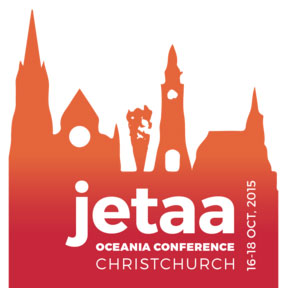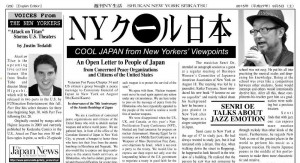Posted by Sydney Sparrow, curriculum and content developer for a real estate school based in Virginia. Click here to join the JETwit Jobs Google Group and receive job listings even sooner by email.
Event: Employing JETs Seminar
Posted by: JET Alumni Association UK
Location: Swedenborg Hall, 20-21 Bloomsbury Way, London, WC1A 2TH (Closest Underground: Holborn)
Date: December 9, 2015 from 18:00 to 20:00 pm
Wanting to work in Japan related employment? Just returned from JET, or been back a while but looking for a career change?
Japan Local Government Centre (CLAIR London) will hold a Employing JETs’ Seminar, which is an opportunity for former JETs looking to work in Japan related employment in the UK. The event will be on 9th December at Swedenborg Hall, 20-21 Bloomsbury Way, London, WC1A 2TH (Closest Underground: Holborn).
The 30 years anniversary of the JET Programme will be celebrated in 2016, and with an increasing focus on post JET links in business and citizens diplomacy this event will explain how JETs use their experience for work, with speeches from companies who employ people who have been on the JET Programme, as well as former JETs employed by them. This is also an excellent opportunity for JETs to network with representatives of Japanese business in the UK.
Companies attending include: Marubeni, Mitsui, Shinsei International, Japan England Insurers, Chubu Electric Power, Nomura International and others.
If you wish to attend this free event, please apply by email to mailbox@jlgc.org.uk with your name, title, current role and where and when you were on JET by Friday November 27th. Spaces are limited and will be on a first come first served basis.
Posted by Sydney Sparrow, curriculum and content developer for a real estate school based in Virginia. Click here to join the JETwit Jobs Google Group and receive job listings even sooner by email.
Event: 2015 Boston Career Forum
Posted by: Mitsubishi Corporation
Location: Boston, MA
Date: November 20, 2015 (Company seminars begin at 10:00AM)
For almost thirty years the Boston Career Forum has been the standard in Japanese-English bilingual recruitment. As a rare and exceptional opportunity to connect directly with top industry players, students and working professionals alike attend the event to discover exciting new fields and launch fulfilling careers through full-time and internship positions.
Mitsubishi Corporation (MC) will be joining the Boston Career Forum 2015, and plans to hold information sessions specifically for former JET participants on November 20th. They have several former JET participants currently working in a variety of fields across their network, including Human Resources, Corporate Social Responsibility (CSR), Public Relations, Security Trade Control, Global Strategy, Legal, Chemicals Trading, and Global Environment and Infrastructure.
You can learn more about what they do at Mitsubishi Corporation by clicking here.
To join one of their information sessions on November 20th, please pre-register for the Boston Career Forum at the links below.
- Sign up at Career Forum Net (operator of the Boston Career Forum) by clicking here.
- Register for the Boston Career Forum by clicking here.
When you have registered, please look for their company booth at the Career Forum on November 20th. Please note that the objective of these sessions is to share information about Mitsubishi Corporation and are an opportunity for you to share information about your career goals with them.
Mitsubishi Corporation recruits staff based on the specific business needs of each office and subsidiary as they arise. At the information sessions, they will not be interviewing for any specific positions. However, going forward, they would like to keep in touch with capable, highly-motivated ex-JETs in case any suitable positions come up.
2015 JETAA Oceania Conference: Staying Connected
The JETAA Oceania Regional Conference took place in Christchurch, New Zealand this year, over the weekend of Oct 16th-18th. JETAA Oceania is a meeting of chapters from two countries, Australia (5) and New Zealand (3), as well as the respective country representatives. Australia’s Country Representative, Eden Law (ALT Fukushima 2010-2011) reports on the proceedings of the 2015 JETAA Oceania Conference.
As far as I know, the JETAA Oceania Regional Conference is unique in the JETAA world, where two countries share an annual convention – not surprising, considering the geographical proximity and historically close relations (buddies and often times frenemies) of Australia and New Zealand. This year’s theme is “Staying Connected” – to past and present JETs and JET community, local Japanese organisations and cultural groups, sister city initiatives and of course, with other chapters. Because it’s such a core issue to many chapters, we had a lot to say, discuss and share – opinions, ideas and examples that have work and didn’t. Some ideas:
- Maintaining connections with new JETs by following up after a month to see how they are going. If you have a newsletter, ask for article contributions (e.g. “Best experience”, “Most surprising aspect”, “What I should have packed”). These can also be used as material for the next pre-departure orientation.
- Have a committee retreat – have a mini conference by going away to a nice country location to discuss ideas, plan schedule etc.
- Provide some kind of charity work opportunity to give a sense of purpose and satisfaction
- Market JET Programme as a way to gain transitional skills (e.g. being bilingual means you can see things from different viewpoints)
- Sell JET as a professional development program
- For a fun fundraising idea, have a trivia night where answers/clues can be bought for a small fee. Cheat for charity!
This conference also marks my presentation debut as a shiny, newly minted country representative, which was also the same for my New Zealand equivalent, Raewyn MacGregor. Our presentations were about what we’d do as CRs, considering that the role tended to be re-invented to suit each new candidate’s needs and personality. Apart from trying to reduce the wheel-reinvention aspect by keeping records and procedure documentation, we will also aim to focus on community and communication. To that end, I put forward a proposal to have regular, scheduled Google Hangouts for Oceania to keep in touch and continue the flow of dialogue, ideas and support for each other (and if possible, get some participants from outside Oceania to join in!). We will also look at ways of supporting recent returnees, whether in the form of support, mentorship or career opportunities.
We also discussed the Satogaeri Project and the Tokyo November conference, where Satogaeri representatives from several countries (and AJET) will meet and discuss several ideas, such as next year’s 30th Anniversary celebratory plans, and, most interestingly of all, the possible revival of JETAA International (JETAAI). This chapter had gone dormant for the last few years since losing funding during austerity measures implemented by previous governments. For some of you out there, you may be aware of (or have participating in) the short bursts of email communications regarding this chapter. From the documentation presented by CLAIR at the conference, it’s now clear why this was occuring, as JETAAI’s revival looks fairly certain, with proposed committee members election to be held (presumably with those present). There are other further surprising items on the agenda regarding country representatives, so I’ll await the post-conference report with interest.
On a final note, it became clear that the common ingredient running through all successful ideas was networking – building and maintaining relationships which can be tapped into for opportunities. This does require work and commitment – as is the case with anything worthwhile. You can’t go at it half-arsed if you intend to make things a success, after all. Special thanks go to our great chapter hosts, New Zealand’s JETAA South Island, lead by president Caroline Pope (and NZ’s Satogaeri representative) who ran a very efficient and tight ship, which our visiting CLAIR official from Tokyo even remarked on, as being better organised than recent conferences that he had attended. High praise indeed!
The conference site is still up in the meantime. Check out all the pics and posts on Twitter and Facebook by searching for #jetaaoc.
Event: SAIS Information Session – AGOS Japan (Japan)
Posted by Sydney Sparrow, curriculum and content developer for a real estate school based in Virginia. Click here to join the JETwit Jobs Google Group and receive job listings even sooner by email.
Intended Audience: Prospective Students
Posted by: Johns Hopkins School of Advanced International Studies
Location: Tokyo, Japan
Date and Time: November 19, 2015, 7:30PM – 9:00PM (local time)
Join Admissions representatives from the top graduate programs of international affairs for an on-site information session. Representatives will present on respective curriculums, career and networking opportunities, as well as admissions requirements. There will also be question and answer period after the presentation.
- Columbia University – School of International and Public Affairs (SIPA)
- Georgetown University – Edmund A. Walsh School of Foreign Service
- Johns Hopkins University – The Paul H. Nitze School of Advanced International Studies (SAIS)
- Tufts University – The Fletcher School of Law and Diplomacy
JET Alum Michael Kotler, a Reischauer Policy Research Fellow at Johns Hopkins School of Advanced International Studies (SAIS), states it’s important to get JET participants to attend these types of programs (whether it is SAIS or some of the other schools) because it opens them up to many new connections that wouldn’t be available on the JET program.
Session Location:
Room 101
Ninomiya Bldg. 18-4
Sakuragaoko-cho, Shibuya-ku
Tokyo, Japan
Event: SAIS Information Session – Tokyo Education USA (Japan)
Posted by Sydney Sparrow, curriculum and content developer for a real estate school based in Virginia. Click here to join the JETwit Jobs Google Group and receive job listings even sooner by email.
Intended Audience: Prospective Students
Posted by: Johns Hopkins School of Advanced International Studies
Location: Tokyo, Japan
Date and Time: November 19, 2015, 8PM – 10PM (local time)
Join Admissions representatives from the top graduate programs of international affairs for an on-site information session. Representatives will present on respective curriculums, career and networking opportunities, as well as admissions requirements. There will also be question and answer period after the presentation.
- Columbia University – School of International and Public Affairs (SIPA)
- Georgetown University – Edmund A. Walsh School of Foreign Service
- Johns Hopkins University – The Paul H. Nitze School of Advanced International Studies (SAIS)
- Tufts University – The Fletcher School of Law and Diplomacy
JET Alum Michael Kotler, a Reischauer Policy Research Fellow at Johns Hopkins School of Advanced International Studies (SAIS), states it’s important to get JET participants to attend these types of programs (whether it is SAIS or some of the other schools) because it opens them up to many new connections that wouldn’t be available on the JET program.
Session Location:
Justin’s Japan: ‘Ghost in the Shell’ returns, ‘Allegiance,’ Jake Shimabukuro
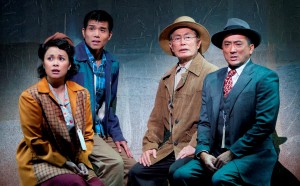
“Allegiance,” a new Broadway musical starring Tony Award winner Lea Salonga (left) and George Takei (second from right) premieres at the Longacre Theatre Nov. 8. (Henry DiRocco)
By JQ magazine editor Justin Tedaldi (CIR Kobe-shi, 2001-02) for Examiner.com. Visit his Japanese culture page here for related stories.
From Broadway to anime to J-pop, November is just as colorful as the leaves gliding through the air. Add to that a cutting-edge Noh-inspired stage spectacle, a classical collegium performance and the return of the undisputed ukulele master, and you’ve got an irresistibly epic rundown.
This month’s highlights include:
Oct. 31-Nov. 1, 12:00 p.m.
We Are Perfume: World Tour 3rd Document
Anthology Film Archives, 32 Second Avenue
$18
This new documentary follows the veteran all-girl pop trio on a two-month international live tour (which made a stop at New York’s Hammerstein Ballroom last November). While traveling around the globe to cities across Asia, Europe, and the United States, audiences will see Perfume’s powerful live performances and catch never before seen behind-the-scenes footage. Witness the group’s single-minded approach to their performances – the joy, anguish, and struggles, not only in the music, but also in fashion and pop culture.
Nov. 2 & 8
Village East Cinema, 181-189 Second Avenue
$14
From the creative team behind Anohana, The Anthem of the Heart tells the story of Jun, once a happy young lady with a tenacious personality. Jun has torn her family apart by saying something hurtful, and her ability to speak has been sealed away by the Egg Fairy in order to stop her from hurting others. Now, Jun lives in the shadows and avoids the limelight. But when she is nominated to become the executive member of the Community Outreach Council and appointed as the main lead in the council’s musical, Jun will have to find her voice and the wisdom to temper her words. Presented in Japanese with English subtitles.
Nov. 3, 5-8
BAM Harvey Theater, 651 Fulton Street (Brooklyn)
$25-$70
An angel’s garment, possessed of mysterious powers, falls to a remote island on Earth, where it is found by a poor fisherman. To get it back, the angel offers up her greatest celestial gift: a dance of incomparable beauty. Dance icons and former New York City Ballet principals Wendy Whelan and Jock Soto, contralto Katalin Károlyi and tenor Peter Tantsits, and puppets by Chris Green come together in this inspired reimagining of a Japanese Noh theater classic. With choreography by David Neumann, costumes by Belgian fashion icon Dries Van Noten, and an original score by Nathan Davis—performed live by the International Contemporary Ensemble and Brooklyn Youth Chorus—Hagoromo merges genres to send a stranded spirit back to heaven.
For the complete story, click here.
Justin’s Japan: LuckyRice New York Slurpfest Serves up Ramen Heaven on Earth
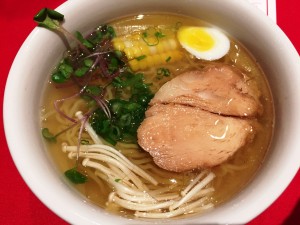
Gator Shio Ramen from Crane Ramen of Gainesville, presented at LuckyRice New York Slurpfest 2015. (Justin Tedaldi)
By JQ magazine editor Justin Tedaldi (CIR Kobe-shi, 2001-02) for Examiner.com. Visit his Japanese culture page here for related stories.
Imagine a place where a variety of regional ramen from around the world is served all in one night. Enter New York Slurpfest 2015, which was held Oct. 22 at Astor Center in Manhattan, featuring dishes from places as diverse as Florida, Fukuoka, Hawaii and Rhode Island—a ramen lover’s dream event.
Slurpfest, which is organized by New York-based Asian culinary event producers LuckyRice, was first held in 2013 and is expected to continue from the looks of last week’s participants, all slurping ramen with smiling faces.
“LuckyRice was founded seven years ago to bring awareness to [Asian] culture, and food is the most universal medium,” said LuckyRice founder Danielle Chang, who rhapsodized about ramen with guests throughout the evening.
“This simple staple has become this glorified chef cuisine,” she added, noting that the amount of ramen restaurants in Japan alone outnumbers every McDonald’s location on the planet.
My evening began with an intriguing dish originating from Crane Ramen in Gainesville called Gator Shio Ramen, which was made with a surprisingly refreshing salt broth topped with corn, greens, quail egg, and alligator tail chashu.
For the complete story, click here.
Justin’s Japan: ‘Naruto’ takes Comic Con, ‘Legend of Zelda,’ L’Arc~en~Ciel
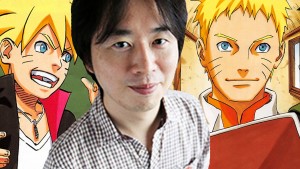
Naruto creator Masashi Kishimoto makes his first-ever appearances outside of Japan in New York Oct. 7-10. (Courtesy of ForeverWorld)
By JQ magazine editor Justin Tedaldi (CIR Kobe-shi, 2001-02) for Examiner.com. Visit his Japanese culture page here for related stories.
The Japan-centric events of the month ahead promise to be as rich and full as autumn itself—brisk and colorful, with a dash of unpredictability.
This month’s highlights include:
Oct. 8-11
Jacob K. Javits Convention Center, 655 West 34th Street
Limited tickets available
The East Coast’s biggest gathering for fans of comics, film, anime and manga, New York Comic Con returns with its biggest roster of Hollywood talent to date, including the first-ever appearance outside of Japan of Naruto creator Masashi Kishimoto, on hand for an exclusive Q&A panel (Oct. 8, 5:30 p.m.) as well as the North American theatrical debut (Oct. 10, 11:30 a.m. at Hammerstein Ballroom) of Boruto: Naruto the Movie! In addition, Kishimoto will also make live appearances at Apple Store SoHo (Oct. 7, 7:00 p.m.), Kinokuniya Book Store (Oct. 9, 8:30 p.m.) and Barnes and Noble Tribeca (Oct. 10, 3:30 p.m.). Don’t miss this chance to meet one of Japan’s most popular contemporary manga artists!
Oct. 9-Jan. 10
For a New World to Come: Experiments in Japanese Art and Photography, 1968-1979 Japan Society Gallery, 333 East 47th Street
$12 students and seniors, $10, Japan Society members. Free on Friday nights, 6:00-9:00 p.m.
In the wake of the social and political upheaval of the late 1960s, Japanese artists and photographers began crafting a new visual language for an age of uncertainty. Their embrace of camera-based experiments would alter the cultural landscape and lay the foundations for contemporary art in Japan. For a New World to Come is the first comprehensive exhibition to spotlight this radical break with the past. With some 200 works by such luminaries as Ishiuchi Miyako, Daidō Moriyama, Jirō Takamatsu, and Shōmei Tōmatsu, the exhibition charts the stunning diversity of photographic practices during this pivotal era, from conceptual series situated squarely within global artistic currents, to visually arresting meditations on time, place, and self.
Oct. 10, 12, 13, 17, 19, 21
Village East Cinema, 181-189 2nd Ave.
$15
See the next generation of Naruto on the big screen! With Naruto as the Seventh Hokage, Hidden Leaf Village is planning to host the Chunin Exams to train new shinobi. Among the entrants are Sasuke’s daughter, Sarada, who adores Naruto, Mitsuki, an exceptionally talented yet mysterious shinobi, and Boruto, Naruto’s son who shows great potential, but despises his father. Sasuke, who’s been on a mission in another dimension, appears before Naruto to warn of a strange impending danger he has sensed. An inconceivable foe lies in wait as Sasuke, the Five Kage, and Boruto charge into another dimension!Presented in Japanese with English subtitles.
For the complete story, click here.
Nippon in New York: ‘Attack on Titan,’ Taylor Anderson Memorial, Luckyrice Fest

The live-action film debut of Attack on Titan premieres at Village East Cinema Sept. 30. (Courtesy of FUNimation)
By JQ magazine editor Justin Tedaldi (CIR Kobe-shi, 2001-02) for Examiner.com. Visit his Japanese culture page here for related stories.
As the summer winds fade into fall colors, the weeks ahead are shaping up with these exciting events, ready to be enjoyed after Labor Day.
This month’s highlights include:
Tuesday, Sept. 8, 6:30 p.m.
Japanese Design Today: Unique, Evolving, Borderless
UL105, University Center, The New School, 63 Fifth Ave.
Free (click here to register)
Japanese design has been proven capable of transcending language barriers and fostering communication and understanding between cultures, enthusiastically embracing elements of other cultures while developing and retaining its own unique sense of design aesthetic, which today is recognized and appreciated throughout the world. But as Japanese society has transformed socially, geopolitically, and economically, so has Japanese design transformed to accommodate these changes which has given way to a new era. Hiroshi Kashiwagi, professor at Musashino Art University, and architect/ furniture designer Yoshifumi Nakamura will each discuss the evolution, distinguishing characteristics, and current state of Japanese design today. A Q&A session will follow the presentations.
Friday, Sept. 11, 7:00 p.m.
The Concert Hall — New York Society for Ethical Culture, 2 West 64th Street
$20
Celebrating its eighth annual concert, this year Circle Wind will give tribute to Taylor Anderson, an American victim of the the Great East Japan Earthquake/Tsunami on March 11, 2011. Anderson was dispatched to Ishinomaki under The Japan Exchange and Teaching (JET) Program in 2008 and was teaching English to schoolchildren there. The newly formed “Never Give Up Taylor’s Choir” from the Ishinomaki/Higashi-Matsushima area will perform an original piece symbolizing their appreciation for the American people’s support to recover from the devastation in 2011. Maestro Gregory Singer and his Manhattan Symphonie Orchestra also returns to perform some tribute songs for Taylor together with koto soloist Masayo Ishigure and other prominent artists. Hosted by New York’s choral harmony group Tomo.
Saturday, Sept. 12
Double feature: Live Your Dream and Dream Beyond 400 Years
Nippon Club of New York, Rose Room, 145 West 57th Street
$10 per film (at 5:00 p.m. and 6:45 p.m.)
Live Your Dream is a story about the courage and sacrifice of Taylor Anderson and for all the young people who travel the world trying to make a difference. Taylor was an extraordinary American who on the JET Program dedicated herself to teaching Japanese children, living her dream right up to the disaster of March 11, 2011. In the New York premiere of Dream Beyond 400 Years, local choir Tomo took a journey to Coria Del Rio in Spain, representing a journey going beyond 400 years. In this town, they met “Japón-san,” the descendants of Japanese travelers to Spain 400 years ago. The members of Tomo and Japón-san form a lifelong friendship in this touching real-life story. An after-screening reception featuring Circle Wind Concert participants and members of Taylor Anderson’s family will be held at 7:30 p.m. ($40).
For the complete story, click here.
Justin’s Japan: ‘Attack on Titan’ Storms U.S. Theaters
By JQ magazine editor Justin Tedaldi (CIR Kobe-shi, 2001-02) for Shukan NY Seikatsu. Visit his Examiner.com Japanese culture page here for related stories.
Attack on Titan is the upcoming live-action feature film from Studio Toho and director Shinji Higuchi, which will be released in two parts in the U.S. by FUNimation Entertainment this fall. Part One hits select theaters for three days beginning Sept. 30, with Part Two following Oct. 20.
Originally created by manga artist Hajime Isayama in 2009 and currently published by Kodansha Comics in the U.S., Attack on Titan has over 50 million copies in print, as well a 25-episode anime series, also produced by FUNimation for American audiences. The series is so popular that a special Titan-themed attraction opened at Universal Studios Japan earlier this year.
The film’s official U.S. release comes swiftly after Part One’s world premiere at the Egyptian Theater in Los Angeles on July 14 and its Japanese release on Aug. 1. Written by Yusuke Watanabe, the films star Haruma Miura and Kiko Mizuhara as two young soldiers living in a deadly post-apocalyptic land where humans fight man-eating Titans for their very survival.
“FUNimation is honored to host the world premiere of Attack on Titan here in the United States with Toho,” said FUNimation president and CEO Gen Fukunaga in a press release. “Attack on Titan is truly a worldwide phenomenon and we are excited to bring the live-action movie to theaters.”
For more information, visit http://attackontitanthemovie.com.
Posted by Sydney Sparrow, curriculum and content developer for a real estate school based in Virginia. Click here to join the JETwit Jobs Google Group and receive job listings even sooner by email.
Event: 2015 Careers and Networking Night
Posted By: JETAA NSW
Location: The Japan Foundation – L4, Central at Central Park. 28 Broadway. Chippendale, NSW 2008 AU
When: Friday, 18 September 2015 from 6:00 PM to 8:00 PM (AEST)
Looking for networking opportunities? Perhaps a potential Japan related career change? Or simply want to find out more about life on the JET Programme and beyond?
Our 2015 Careers and Networking Night is our JETAA way of welcoming back our returning JETs who have finished up their year on the programme.
But most importantly, it is an opportunity to network and re-connect for the JETAA community here in Sydney, both old and new. Not only is it about getting in touch with your peers, it is also a potential opportunity to meet new people as part of the extensive JETAA network, which can pay off in unexpected ways.
Doors open from 6pm, food and drink are provided, and entry is completely free!
To RSVP, please email info@jetaansw.org.au or sign up at eventbright: https://www.eventbrite.com.au/e/jetaa-nsw-careers-night-tickets-18412172303
WIT Life #291: Waku Waku +NYC event and Sebastian Masuda

Sebastian Masuda with protege Kyary Pamyu Pamyu
WIT Life is a periodic series written by professional Writer/Interpreter/Translator Stacy Smith (Kumamoto-ken CIR, 2000-03). She starts her day by watching Fujisankei’s newscast in Japanese, and here she shares some of the interesting tidbits and trends along with her own observations.
This weekend I had the chance to visit “Waku Waku +NYC,” a new Japanese pop culture festival which took place over two days across multiple venues in Greenpoint and Williamsburg. According to the event’s homepage, it brings together the worlds of anime, manga, music, food, film, and fashion via exhibits, panels, screenings, and interactive events. This blend of pop culture from Japan and Brooklyn was envisioned as “Cool Japan meets New York’s Coolest Borough.” The name Waku Waku (わくわく) Read More
Japan Local: Aomori 10 City Festival in Mutsu
Mel T (Aomori-ken, 2007-2012) is a Canadian living and working in Towada City, Aomori. For more information about events, sightseeing, restaurants, etc. in Towada City, and around Aomori Prefecture & Japan, visit her blog at http://towada-city.blogspot.com.
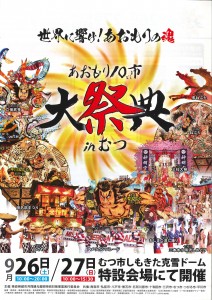 Miss out on the Aomori Summer Festivals and don’t want to wait a whole year for your next chance to see them?
Miss out on the Aomori Summer Festivals and don’t want to wait a whole year for your next chance to see them?
Check out the Aomori 10 City Festival in Mutsu from September 26-27th, 2015!
The Aomori 10 City Festival showcases major festivals, food, products and more from 10 cities around Aomori Prefecture: Aomori City, Hirosaki City, Hachinohe City, Kuroishi City, Goshogawara City, Towada City, Misawa City, Mutsu City, Tsugaru City, and Hirakawa City.
The must-see attraction is the Saturday night festival parade featuring Nebuta/Neputa floats, nagashi odori, etc., but you can also enjoy stage performances, appearances by mascot characters, delicious local foods and more at the event.
Japan Local: B-1 Grand Prix in Towada
Mel T (Aomori-ken, 2007-2012) is a Canadian living and working in Towada City, Aomori. For more information about events, sightseeing, restaurants, etc. in Towada City, and around Aomori Prefecture & Japan, visit her blog at http://towada-city.blogspot.com.
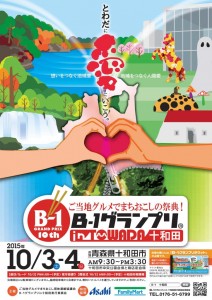 Interested in trying out local “soul foods” from all over Japan?
Interested in trying out local “soul foods” from all over Japan?
Then the 10th B-1 Grand Prix in Towada is the event for you!
From October 3rd-4th, 2015, sixty-two groups from across Japan will gather in Towada (Aomori Prefecture) to promote their respective cities and local “soul foods”. Enjoy soba, udon, ramen, rice bowls, curry, fried foods, grilled meats, and various other dishes originating from Hokkaido to Kyushuu and vote for your favourite group. At the end of the second day, the most popular group–as selected by attendees–will be awarded the Gold Grand Prix Prize (symbolized by giant golden chopsticks :P).
Often misunderstood as standing for “B-grade” (“B級” B-kyuu in Japanese), the “B” in “B-1” actually stands for “brand.” The goal of the B-1 Grand Prix is to revitalize cities and towns through the promotion of their respective local brands. Apart from serving delicious food, participating groups also try to demonstrate their own unique brand of hospitality through performances, etc. This is why attendees of the B-1 Grand Prix are encouraged to vote for their favourite group and not just the best dish.
So if you want to get a taste of many different cities from around Japan, come to Towada for the B-1 Grand Prix.
十和田に愛に行こう!Towada ni ai ni ikou! Come to love Towada!
Official Website (Japanese): http://b-1towada.com/
Click HERE to learn MORE (English)
Justin’s Japan: Nippon in New York—‘Dragon Ball Z,’ Liberty City Anime Con, Waku Waku NYC

Dragon Ball Z: Resurrection ‘F’ premieres the week of Aug. 3 at three Manhattan-area locations. (FUNimation)
By JQ magazine editor Justin Tedaldi (CIR Kobe-shi, 2001-02) for Examiner.com. Visit his Japanese culture page here for related stories.
In the dog days of summer, it’s best to escape the heat in a place that’s cozy and cool. For those into Japanese cultural events, this month offers a diverse selection of film premieres and live music—all in the comfort of indoor air conditioning.
This month’s highlights include:
Aug. 4, 5, 7, 8 & 11
Dragon Ball Z: Resurrection ‘F’
AMC Empire 25, 234 West 42nd Street
Chelsea Cinemas, 260 West 23rd Street
Village East Cinema 7, 181-189 2nd Avenue
$15
Hot on the heels of last year’s summer blockbuster, Battle of Gods, Resurrection ‘F’ is the second film personally supervised byDBZ creator himself, Akira Toriyama. The new movie showcases the return of Frieza, the galaxy’s most evil overlord. After years in spiritual purgatory, Frieza has been resurrected and plans to take his revenge on the Z-Fighters of Earth. Facing off against Frieza’s powerful new form and his army of 1,000 soldiers, Goku and Vegeta must reach new levels of strength in order to protect Earth from their vengeful nemesis. English dub version.
Friday, Aug. 28, 6:00 p.m.
Always: Sunset on Third Street 3
Japan Information Center Gallery, Consulate General of Japan in New York
299 Park Avenue, 18th floor
Free (email RSVP to kanako_shirasaki[at]jfny.org; photo ID required upon entry)
A special screening of the third film in the wildly popular series! In 1964, novelist Ryunosuke Chagawa (Hidetaka Yoshioka) has married Hiromi (Koyuki), and the two now share a happy life with Junnosuke (Kenta Suga), the young boy he had taken in during the first film, who is now in high school. Hiromi is also pregnant, and the family prepares to welcome a new addition to their household. One day, Hiromi discovers a telegram that Chagawa had hidden. Who sent this telegram? What is the surprising identity of this new, rival writer? And what future awaits the people of Third Street? Presented in Japanese with English subtitles.
Aug. 28-30
Crowne Plaza White Plains, 66 Hale Avenue
$50 for weekend pass
The best three-day anime convention (just north of) New York City, the inaugural Liberty City Anime Con features over 100 events and panels, a dozen guests and entertainers, three days of cosplay, game tournaments and anime screenings, and concerts, balls and dances. Guest performers include idol singer Reni Mimura, female J-pop group Starberry, and New Jersey-based anime, video game and J-pop cover band Moshi Moshi.
For the complete story, click here.

